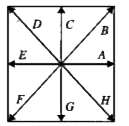ABCDEF si a regular hexagon with centre at the origin such that A→D+E→B+F→C=λE→D. Then, λ equals
2
4
6
3
The correct Answer is:B
To solve the problem, we need to analyze the vectors associated with the regular hexagon ABCDEF centered at the origin. We are given the equation:
→AD+→EB+→FC=λ→ED
1. Understanding the Hexagon:
- A regular hexagon has six vertices (A, B, C, D, E, F) and is symmetric about its center (O). The coordinates of the vertices can be represented in terms of angles. For a hexagon centered at the origin, we can assign coordinates as follows:
- A(1,0)
- B(12,√32)
- C(−12,√32)
- D(−1,0)
- E(−12,−√32)
- F(12,−√32)
2. Finding the Vectors:
- We need to express the vectors →AD, →EB, and →FC:
- →AD=→D−→A=(−1,0)−(1,0)=(−2,0)
- →EB=→B−→E=(12,√32)−(−12,−√32)=(1,√3)
- →FC=→C−→F=(−12,√32)−(12,−√32)=(−1,√3)
3. Summing the Vectors:
- Now, we sum these vectors:
→AD+→EB+→FC=(−2,0)+(1,√3)+(−1,√3)
- Simplifying this gives:
(−2+1−1,0+√3+√3)=(−2,2√3)
4. Expressing →ED:
- Now we need to express →ED:
- →ED=→D−→E=(−1,0)−(−12,−√32)=(−12,√32)
5. Finding λ:
- We need to find λ such that:
(−2,2√3)=λ(−12,√32)
- This gives us two equations:
- For the x-component: −2=−λ2 → λ=4
- For the y-component: 2√3=λ√32 → λ=4
Thus, we find that λ=4.
Final Answer:
λ=4
- A regular hexagon has six vertices (A, B, C, D, E, F) and is symmetric about its center (O). The coordinates of the vertices can be represented in terms of angles. For a hexagon centered at the origin, we can assign coordinates as follows:
- A(1,0)
- B(12,√32)
- C(−12,√32)
- D(−1,0)
- E(−12,−√32)
- F(12,−√32)
- We need to express the vectors →AD, →EB, and →FC:
- →AD=→D−→A=(−1,0)−(1,0)=(−2,0)
- →EB=→B−→E=(12,√32)−(−12,−√32)=(1,√3)
- →FC=→C−→F=(−12,√32)−(12,−√32)=(−1,√3)
- Now, we sum these vectors:
→AD+→EB+→FC=(−2,0)+(1,√3)+(−1,√3)
- Simplifying this gives:
(−2+1−1,0+√3+√3)=(−2,2√3)
- Now we need to express →ED:
- →ED=→D−→E=(−1,0)−(−12,−√32)=(−12,√32)
- We need to find λ such that:
(−2,2√3)=λ(−12,√32)
- This gives us two equations:
- For the x-component: −2=−λ2 → λ=4
- For the y-component: 2√3=λ√32 → λ=4
λ=4
Topper's Solved these Questions
- ALGEBRA OF VECTORSBOOK - OBJECTIVE RD SHARMA ENGLISHCHAPTER - ALGEBRA OF VECTORSEXERCISE - Exercise
30 Videos
- ALGEBRA OF VECTORSBOOK - OBJECTIVE RD SHARMA ENGLISHCHAPTER - ALGEBRA OF VECTORSEXERCISE - Chapter Test
30 Videos
- ALGEBRAIC INEQUATIONSBOOK - OBJECTIVE RD SHARMA ENGLISHCHAPTER - ALGEBRAIC INEQUATIONSEXERCISE - Exercise
39 Videos
Similar Questions
ABCDEF is a regular hexagon with centre a the origin such that −−→AB+−−→EB+−−→FC=λ−−→EDthenλ= (A) 2 (B) 4 (C) 6 (D) 3
View SolutionABCDEF is a regular hexagon. Find the vector →AB+→AC+→AD+→AE+→AF in terms of the vector →AD
View SolutionIf ABCDEF is a regular hexagon, them →AD+→EB+→FC equals 2→AB b. →0 c. 3→AB d. 4→AB
View SolutionIn a regular hexagon ABCDEF, −−→AE
View SolutionConsider the regular hexagon ABCDEF with centre at O (origin).
Q. AD+EB+FC is equal to
View SolutionIf ABCDEF is a regular hexagon then −−→AD+−−→EB+−−→FC equals :
View SolutionIf ABCDEF is a regular hexagon with −−→AB=→a and −−→BC=→b, then −−→CE equals
View SolutionA number of vectors are as shown in .They can be combined in various ways , like →A+→C=→B . What is the value of (a) →E+→C (b) →A+→F (c ) →A+→D (d) →E+→A (e ) →A−→B .

View SolutionIf ABCDEF is a regualr hexagon, then −−→AC+−−→AD+−−→EA+−−→FA=
View SolutionABCDE is a pentagon. Prove that the resultant of force →AB, →AE ,→BC ,→DC ,→ED and →AC ,is 3→AC .
View Solution
